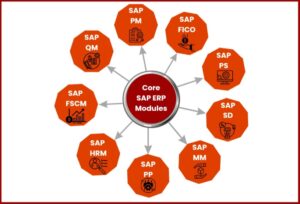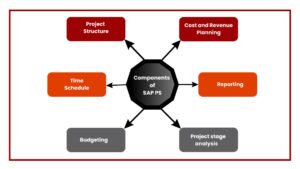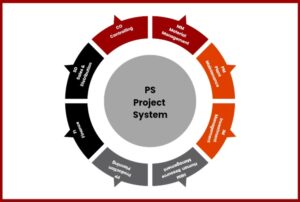Introduction to SAP Project System (PS)

All ERP software supports every business process with its distinct modules helping to gain better visibility of analytics and in turn easing the entire cycle of operations of each module’s distinct process. SAP is one such player in the ERP world with 40+ years of expertise in providing unique business solutions drafted for your business’s needs.
The core business modules offered by the SAP ERP software are:
- Human Resource Management (SAP HRM)
- Production Planning (SAP PP)
- Material Management (SAP MM)
- Financial Supply Chain Management (SAP FSCM)
- Sales and Distribution (SAP SD)
- Project System (SAP PS)
- Financial Accounting and Controlling (SAP FICO)
- Plant Maintenance (SAP PM)
- Quality Management (SAP QM)
This article focuses on elaborating on the core functionalities of the SAP PS (Project System) module. Let’s dive in to understand Project System before knowing about SAP PS.
Introduction to SAP Project System (PS):
The Project and Portfolio Management solution from SAP includes the SAP Project System (PS). Project System assists in managing projects at all stages of their lifespan, from conception through the production of plans, and project execution till project conclusion.
The SAP PS Module may be used specifically for big and complex projects including building, production, service, and investment projects across all sectors because of its close interface with SAP’s Finance and Logistics modules.
One of SAP PS’s advantages as a project management tool is its ability to integrate with other SAP modules, as seen in the image below, as well as with third-party project management tools from non-SAP systems, such as Primavera and Microsoft Project.
Apart from its ability to interact with other SAP modules, SAP PS becomes even more adaptable when you consider how effectively it integrates with third-party project management systems like Microsoft Project and Primavera. But first, let’s go through some of the solution’s primary features and benefits.
Let’s get started; your company can benefit the following benefits through the implementation of the SAP Project System (PS):
• Following up with customers and internal initiatives in a systematic and thorough manner
• The project office, logistics units, and finance department utilize the same platform
• Phase-by-phase project profitability
• Resource consumption statistics
Components of SAP PS:
Project Structure:
This is the process of developing work packages for projects utilizing Network Plans and Work Breakdown Structure (WBS) Elements that are unique to SAP PS.
Time Schedule:
The process of developing a project time schedule, putting steps in work packages (WBS components) that are unique to a project on a time schedule based on the project calendar, and keeping track of employees’ actions.
Cost and Revenue Planning:
This entails budgeting for costs and revenues for the tasks in work packages (WBS elements).
Budgeting:
Budget management and availability controls are achieved by budgeting the projects as well as the work packages (WBS parts) that make up the projects.
Project stage analysis:
The Project stage analysis provides us with a step-by-step progress analysis and project status analysis.
Reporting:
This refers to the delivery of numerous reports about the projects’ hierarchy, financial (G/L Account and line item), material, resource, and project progress status.
Integration with other Modules:
- Controlling (SAP CO) – Project Systems vastly integrated with CO Module starting from Cost Planning, Result Analysis, Settlement, etc.
- Material Management (SAP MM) – Project System has the capability to create reservations, PR & PO via Easy Cost Planning .
- Sales & Distribution (SAP SD) – Project System processes are integrated with SD & can be linked to a project. Dynamic Item Processors (DIP) profiles also helped to auto creation of sales documents.
- Finance (SAP FI) – All expenditures of the Project System are mainly linked to FI.
- Plant Maintenance (SAP PM) – Maintenance orders can be connected with the SAP Project System where there is the involvement of a large number of equipment in a project.
- SAP Investment Management (SAP IM) – IM is integrated with SAP PS to manage Asset Under Construction.
- Human Resource Management (SAP HRM) – Resources deployment in a project can be managed through HR.
- Production Planning ( SAP PP) – Helps in analysing, reporting and sharing of data for better efficiency and cost reduction.
Reasons to choose SAP PS
- Complete integration with additional SAP components.
- Constantly and closely observing every area of the project.
- Enterprise transactions involving materials, costs, and resources are integrated in real-time.
- A flexible billing procedure that complies with various accounting constraints
- Adherence to several corporate security regulations.
- High productivity for routine chores.
- Reliable reporting on project performance that drills down to the smallest level of transactional information.
- High data integrity.
Further, SAP PS makes a distinction between projects with external funding (client projects) and those with internal funding (capital investment projects and overhead cost projects). In truth, the PS module’s multifaceted versatility is rather impressive; in addition to its flawless connection with other SAP components, it can also be coupled with third-party project management tools.
Basically, SAP PS is capable of the exact planning, management, and revenue/cost reporting needed to make your project a success, whether we’re talking about large-scale projects (like building a bridge) or small-scale projects (like hosting a trade show).
Final Thoughts
You can forecast, assess, and manage expenses and revenues with SAP PS. You’ll also improve your time management and resource management. Kaar Tech can assist you if you’re all set to use SAP PS or if you simply want to learn more about what the module can achieve for your business.
Our team of SAP experts with offices can assist you in integrating the solution and advise your company on the optimal integration approach to meet your business objectives.
Feel free to reach out to us, by clicking on to this link!
FAQ’S
What is SAP PS?
The Project and Portfolio Management solution from SAP includes the SAP Project System (PS). Project System assists in managing projects at all stages of their lifespan, from conception through the production of plans, and project execution till project conclusion.
List the components of SAP PS
SAP PS includes Project Structure, Time Schedule, Cost and Revenue Planning, Budgeting, Project Stage Analysis, and Reporting as its core components.
What are the integration modules with SAP PS?
SAP PS integrates closely with SAP CO (Controlling), SAP MM (Material Management), SAP SD (Sales & Distribution), SAP FI (Finance), SAP PM (Plant Maintenance), SAP IM (Investment Management), SAP HRM (Human Resource Management), and SAP PP (Production Planning).
Why choose SAP PS?
Reasons to choose SAP PS include complete integration, real-time oversight, enterprise transaction integration, flexible billing, adherence to security regulations, high productivity, detailed reporting, data integrity, and versatility in managing projects with different funding sources.



